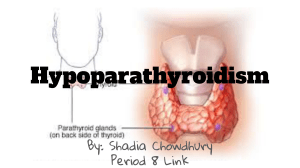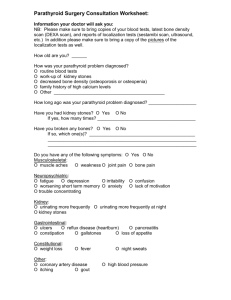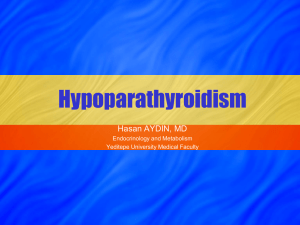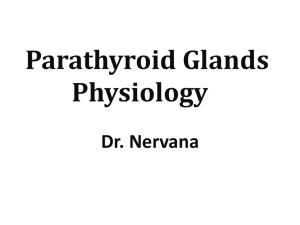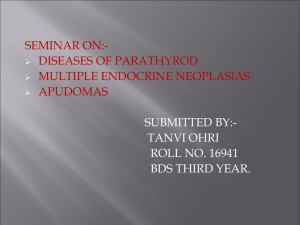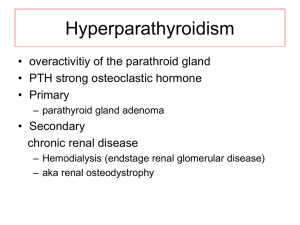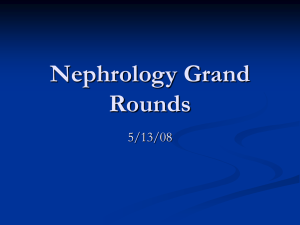Medical References WHAT IS HYPOPARATHYROIDISM?
advertisement
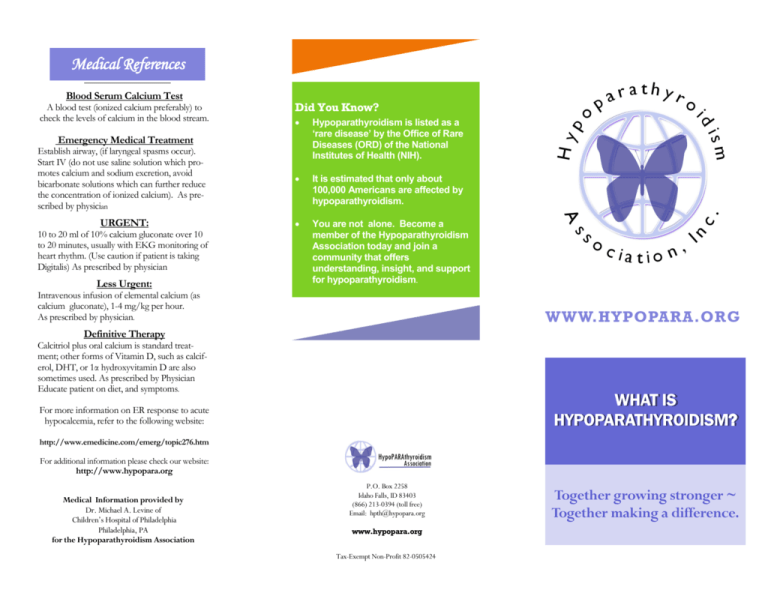
Medical References Blood Serum Calcium Test A blood test (ionized calcium preferably) to check the levels of calcium in the blood stream. Did You Know? Establish airway, (if laryngeal spasms occur). Start IV (do not use saline solution which promotes calcium and sodium excretion, avoid bicarbonate solutions which can further reduce the concentration of ionized calcium). As prescribed by physician Hypoparathyroidism is listed as a ‘rare disease’ by the Office of Rare Diseases (ORD) of the National Institutes of Health (NIH). It is estimated that only about 100,000 Americans are affected by hypoparathyroidism. URGENT: You are not alone. Become a member of the Hypoparathyroidism Association today and join a community that offers understanding, insight, and support for hypoparathyroidism. Emergency Medical Treatment 10 to 20 ml of 10% calcium gluconate over 10 to 20 minutes, usually with EKG monitoring of heart rhythm. (Use caution if patient is taking Digitalis) As prescribed by physician Less Urgent: Intravenous infusion of elemental calcium (as calcium gluconate), 1-4 mg/kg per hour. As prescribed by physician. WWW.HYPOPARA.ORG Definitive Therapy Calcitriol plus oral calcium is standard treatment; other forms of Vitamin D, such as calciferol, DHT, or 1α hydroxyvitamin D are also sometimes used. As prescribed by Physician Educate patient on diet, and symptoms. WHAT IS HYPOPARATHYROIDISM? For more information on ER response to acute hypocalcemia, refer to the following website: http://www.emedicine.com/emerg/topic276.htm For additional information please check our website: http://www.hypopara.org Medical Information provided by Dr. Michael A. Levine of Children’s Hospital of Philadelphia Philadelphia, PA for the Hypoparathyroidism Association P.O. Box 2258 Idaho Falls, ID 83403 (866) 213-0394 (toll free) Email: hpth@hypopara.org www.hypopara.org Tax-Exempt Non-Profit 82-0505424 Together growing stronger ~ Together making a difference. Idiopathic: G ENERAL INFORMATION : H YPOPARATHYROIDISM (HPTH) Description The parathyroid glands produce and release parathyroid hormone (PTH) in response to a low level of ionized calcium. PTH raises the serum calcium level and reduces the serum phosphate level. Hypoparathyroidism (HPTH) is a condition in which the parathyroid glands fail to secrete sufficient PTH into circulation to maintain normal control of mineral metabolism. The absence of PTH leads to a disturbance in mineral metabolism in which serum levels of calcium are low and serum levels of phosphate are high. Common Causes of Hypoparathyroidism A term that refers to cases of isolated HPTH where the cause is as yet unknown. Pseudo-HPTH: An unusual condition in which specific target cells of PTH in the kidneys fail to respond appropriately to PTH. Patients with PHP type 1a also have additional hormone defects (e.g. hypothyroidism, growth hormone deficiency, hypogonadism) and physical abnormalities, such as short stature, obesity, shortened fingers or toes, and subcutaneous bone formation, which are collectively termed Albright hereditary osteodystrophy. PHP type 1a is due to mutations in the copy of the GNAS gene that has been inherited from the mother. Identical defects on the paternal GNAS gene lead to Albright hereditary osteodystrophy with normal hormone action (termed pseudopseudohypoparathyroidism) or progressive osseous heteroplasia, a condition characterized by extensive ectopic ossification (bone formation). Other patients with PHP have a normal physical appearance and no additional endocrine defects. This form of PHP is termed PHP type 1b, and is due to imprinting defects that block expression of the maternal copy of the GNAS gene. Surgical : Damage or removal of parathyroid glands after surgery of structures in the neck, e.g. Thyroidectomy, Laryngectomy, or Parathyroidectomy. Pathophysiology of HPTH and Pseudo-HPTH Isolated: When untreated, all forms of HPTH and Pseudo-HPTH are assocated with Hypocalcemia (low calcium levels in the blood) and Hyperphosphatemia (high phosphate levels in the blood). The degree of Hypocalcemia and Hyperphosphatemia can be highly variable from patient to patient, and even within an individual patient can fluctuate over time. The lack of PTH, or lack of PTH effect, leads to inadequate synthesis of calcitriol (1,25 dihydroxyvitamin D), the most active form of Vitamin D. The lack of calcitriol impairs absorption of calcium from the GI tract and blocks release of calcium from storage sites in the skeleton, thus leading to low levels of calcium in the blood. The lack of PTH affect also causes excessive reabsorption of phosphate in the kidney, which leads to hyperphosphatemia. A group of disorders in which HPTH is the only endocrine or developmental defect. Isolated HPTH may be caused by genetic defects that impair secretion of PTH from the parathyroid glands. Complex Syndromes in Which Hypoparathyroidism Occurs: HPTH can also occur as a component of complex genetic or congenital syndromes in which a variety of tissues or organs are affected. Including DiGeorge syndrome, Hypoparathyroidism– deafness-nephrosis syndrome, or autoimmune polyglandular syndrome type 1. Symptoms of HPTH: The signs and symptoms of HPTH and Pseudo HPTH are largely the result of low serum calcium levels. The physical manifestation of hypocalcemia is tetany, a condition of increased neuromuscular reactivity, which causes muscle cramps in hands and feet, as well as tingling and numbness (particularly around the mouth, fingertips and toes). Bronchospasm and laryngospasm, often simulating a severe asthma attack can occur, as can seizures. These signs and symptoms can be aggravated by hyperventilation. Hyperflexia may occur, and prodomel paresthesias typically precede a tetany attack. Signs and Symptoms of Tetany: Tetany: The hands, forearms, and feet may contort in characteristic pattern, with thumb adduction followed by joint flexion/extension, wrist and elbow. This can be painful. The Chvostek sign is a sign of latent tetany, and can be elicted by tapping on the facial nerve on the cheek in front of the ear, which results in a twitch of the corner of the mouth. The Trousseau sign is contortion of the hand, and occurs either spontaneously with marked hypocalcemia or with milder degrees of hypocalcemia after inflating a blood pressure cuff on the upper arm for 2 to 3 minutes. Rare Central Nervous Effect: Irritability, agitation, anxiety, depression, delirium, psychosis, intellectual impairment, papillodema, seiziures, elevated cerebrospinal fluid pressure, neurological signs. Calcifications of basal ganglia and other regions of the brain. Cardiovascular System Effect: Cardiac dysrhythmias, decreased contractility, reduced cardiac output and heart failure. Other Physical Changes: Cataracts, changes in hair texture, changes in skin pigment and texture, and resistance to skin infections.
